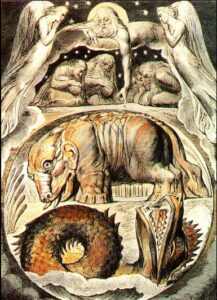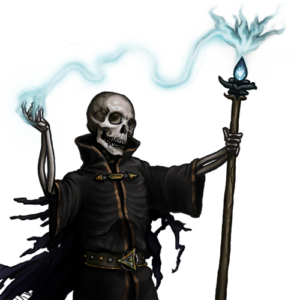Roll for Kabbalah
The connection between Dungeons and Dragons and Jewish mysticism.
Written by: Saryn Taylor, Digital Film Production Instructor
Deep in the dark forest, you spy an interesting link between your favorite role-playing game and a religion full of discovery and history. You roll for intelligence. Nat 20! Let’s dive in.
Dungeons and Dragons (D&D) has been the topic of great fun and debacle since its inception in 1974. It has enthralled players from all over the world to dive into its teachings within a medieval fantasy setting that contains monsters, taverns, and the occasional gelatinous cube. Much like the D’var Torah, those who play D&D often interpret the words in the Dungeon Master’s guide differently and argue about the meaning of one thing over another. For example; “Can I cast fireball in a sealed room?” is basically the same thing as “Is this Kosher for Passover?”.
Unbeknownst to many; however, there are a lot more similarities between the game and the religion than just interpretations about words on a paper. From the golem to the lich, let us see just how many connections can be made between the two.
Golem

A statue of the Prague Golem created for the film The Emperor and the Golem
Crafted out of clay or dirt and brought to life, the golem is one of the most popular creatures from Kabbalah (Jewish mysticism). By writing the Hebrew word emet, which means truth, the little clay man springs to life (L’chaim!) and acts as a helper to its creator. In most stories, the golem turns on its crafter and starts to cause destruction. In order to destroy the golem, it is said to erase the e from emet, turning it into met, the Hebrew word for death, and the golem falls back into the clay it once was.
Now between rolling your dice and searching for your next quest in a dark tavern, you may come across a monster in the D&D world of the same name. While in Judaism, the golem is only made of clay or dirt, there are actually four common different types of this monster portrayed in the role-playing game. The first, and by far the creepiest, is the flesh golem, a creature crafted from human flesh, much like a fantasy version of Frankenstien’s Monster. There is also the clay golem, the one most similar to the one portrayed in Kabbalah, as well as the stone and iron golem. Within various D&D manuals, there are also dozens of other types of golem, including, but not limited to: the stained glass golems, the web golems, and the dragon bone golems. Truly the stuff of nightmares.
Now the largest similarity between the D&D monsters and the Kabbalah creatures is that they have to be created by a person performing a ritual. In the game, it is usually a wizard or cleric that creates the monster and holds power over it, while in Judaism, someone of the faith must inscribe Hebrew lettering onto the creature while reciting a prayer. Both of the golem types also tend to cause destruction. In D&D, the presence is a monster that the party fights, while it could go either way in Jewish folklore. The golem is an understandably frightful creature but doesn’t compare to the monsters ahead.
The Leviathan & The Behemoth

Behemoth and Leviathan, watercolor by William Blake from his Illustrations of the Book of Job (1826).
This pairing makes a gargantuan appearance in Kabbalah and may be the last thing your party sees before ascending to a heavenly plane. The leviathan and behemoth are beasts that conquer the sea and the land, respectively, and have traces back to the story of creation. According to folklore, the leviathan came about on the fifth day and is either the female equivalent to the male behemoth, or both a male and female leviathan were created, but g-d slew the female so they could not reproduce. The leviathan is said to be a humongous sea monster, often like the ones depicted in maps of old. The comparable land monster, behemoth is said to be similar to a hippopotamus and would rule the creatures of the land.
Similar to the golem, these monsters have a lot of similarity with their D&D counterparts. The leviathan is most recognizable, as society recognizes it as a widely accepted definition for “massive sea creature”. Its fantasy role-playing counterpart is also depicted as a dragon-like creation that rules upon the oceans. In D&D, this monster is a chaotic neutral, with the ability to attack using its bite, claws, and tail. The behemoth also builds onto its myth and appears the same way as it does in the stories. With large outward tusks, the behemoth hides in different bodies of water within tropical climates like rivers and swamps. No matter the story, these monsters aren’t afraid to pack a punch on whatever unsuspecting party member graces its presence.
The Lich

A lich from the game The Battle for Wesnoth
While the undead exist in all forms of global folklore, there is a unique connection between Judaism and the lich, a monster spellcaster from the world of D&D. Though the lich doesn’t have an exact counterpart in Kabbalah, it is most similar to a dybbuk, a restless spirit that inhabits the body of a living being. While both are evil beings, the dybbuk can be banished through a Jewish exorcism and the lich has to be destroyed in combat.
Depicted in robes of red, with decaying skin and long nails, the lich is a terrifying monster to face in the game. The monster can resist lightning, cold, and poison as well as strike a paralyzing touch if the player gets close enough. On the surface, there doesn’t seem to be a connection to Judaism, but one key component brings the two together: phylactery.
Phylactery, also known as tefillin, consists of two small boxes containing scrolls. In the Jewish faith, these scrolls are prayers that contain Torah verses such as the Shema and are worn by Jewish men. They act as a conductor to g-d. The boxes, and connected straps, are leather and are adorned on the head and the arm opposite of their dominant hand. While there is limited comparison between Jewish men and an evil undead fantasy monster, both use phylactery as a way to communicate. The lich stores its life force in its phylactery, making it stronger, and is the key component to a cleric or a mage transforming itself into a lich. In D&D, the phylactery isn’t necessarily confined to a small box, but can instead be any small movable object such as jewels, amulets, or in one known case, a golem. These phylacteries can bring spiritual power to both real-life users and monsters within the game, but if you see someone sporting decaying skin and a fondness for lightning blasts, running the other direction is always a good idea.
With thousands of years of Jewish folklore, it’s no wonder that Kabbalah has weaved its way into the realm of Dungeons and Dragons. These monsters on the surface may have differences from the ones they were based upon, but the changes of their story are similar to the evolution of our teachings in Judaism. While the influence of the Jewish people has woven its way into everyday vocabulary and customs, seeing how it’s delved into this subset of nerd culture can help bring people together.

Saryn Taylor, Digital Film Production Instructor
That being said, the next time you are creating a new original character to play with or a dungeon master is crafting a brand-new storyline, think of other ways to incorporate Judaism into your gameplay. Perhaps there is a bard with a love of the fiddle and standing on precarious rooftops or a sorcerer that can part the waves of a treacherous sea. Judaism teaches us to find taglit (discovery) in our everyday lives, so why not include it in our fantasy lives as well?
Please Note: Sources from this article contain notes from Dungeons and Dragons Wikipedia pages and may not contain up-to-date information regarding gameplay.
